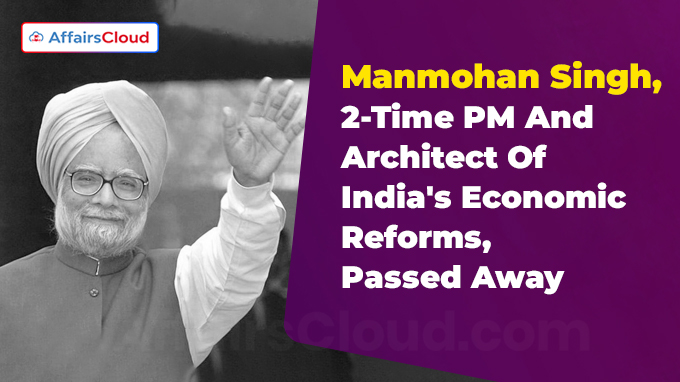 On December 26, 2024, Dr Manmohan Singh, former Indian Prime Minister(PM) and a key architect of India’s economic reforms passed away at the age of 92 in New Delhi (Delhi). He was born on 26 September 1932 in Gah, West Punjab(British India).
On December 26, 2024, Dr Manmohan Singh, former Indian Prime Minister(PM) and a key architect of India’s economic reforms passed away at the age of 92 in New Delhi (Delhi). He was born on 26 September 1932 in Gah, West Punjab(British India).
- Manmohan Singh served as India’s 13th PM from 2004 to 2014 (2 consecutive terms), becoming India’s 4th longest-serving PM.
- He has received the ‘Padma Vibhushan’ and ‘Indira Gandhi Prize for Peace, Disarmament and Development’ award for his exceptional contribution in the Indian Economy Reforms.
About Manmohan Singh:
i.Dr Manmohan Singh began his career as a Senior Lecturer in Panjab University, Chandigarh. In 1971, he became Economic Adviser in the then Ministry of Foreign Trade.
ii.He served as ‘Chief Economic Advisor’ to the Government of India (GoI) from 1972 to 1976; Secretary, Department of Economic Affairs, Ministry of Finance(MoF) from November 1976 to April 1980; Member Secretary, Planning Commission from April 1980 to September 1982.
iii.He served as the 15th Governor of the Reserve Bank of India(RBI) from 1982 to 1985 and also served as the Union Minister of Finance during the PV Narasimha Rao government in 1991 and played a crucial role in shaping India’s economic policy.
iv.He served as the 10th leader of the opposition in the Rajya Sabha (the upper house of the Parliament) during the Atal Bihari Vajpayee government of (1998–2004).
- He also served as a member of the Rajya Sabha, representing the state of Assam from 1991 to 2019 and Rajasthan from 2019 to 2024.
v.He became the 13th PM of India in 2004, leading a coalition government under the Congress-led United Progressive Alliance (UPA).
- He was the 1st Sikh to hold the PM position in India and was known for his personal integrity.
- During his tenure as PM, he negotiated the landmark Indo-USA(United States of America) Civil Nuclear Agreement which ended decades of nuclear isolation for India.
vi.The book, “India’s Export Trends and Prospects for Self-Sustained Growth,” was authored by him and was published by Clarendon Press, Oxford in 1964 , dealt with India’s inward-oriented trade policy.
Economic Initiatives and Changes:
i.Initiation of NSE: The National Stock Exchange (NSE), which was formally launched in 1992, saw significant reforms and expansion during his tenure as the Finance Minister of India.
- The NSE became a crucial part of the broader financial market reforms aimed at improving market infrastructure and increasing foreign investment.
ii.Financial Sector Reforms: India’s financial sector saw major reforms, including the formation of new financial institutions, strengthening of Security and Exchange Board of India (SEBI), and the introduction of private sector banks.
- The banking sector was also modernized and regulated more effectively.
iii.FDI Liberalization:The reforms allowed for a greater inflow of Foreign Direct Investment (FDI), contributing to India’s economic growth and integration with the global economy.
iii.Infrastructure and Economic Growth:The Golden Quadrilateral project aimed at improving connectivity between major cities, was further accelerated during his tenure, alongside the expansion of highways, ports and airports.
- India’s Gross Domestic Product (GDP) growth rose to around 9% annually, placing India among the world’s fastest-growing economies during his tenure.
Important Schemes and Policies under Dr Manmohan Singh:
i.NREGA 2005: National Rural Employment Guarantee Act 2005 (NREGA), later renamed the Mahatma Gandhi National Rural Employment Guarantee Act (MGNREGA), was launched during his time as PM.
- Objective: It guaranteed at least 100 days of wage employment per year to every rural household willing to do unskilled manual labor aimed at alleviating poverty, reducing rural unemployment.
ii.RTI Act 2005:The Right to Information (RTI) Act 2005, which was enacted in 2005, a transparency law that gave citizens the legal right to access information about government functioning aimed to promote government accountability and reduce corruption.
iii.Rural and Urban Development Initiatives:The rural development, including the Pradhan Mantri Gram Sadak Yojana (PMGSY), aimed at improving rural roads and Indira Awaas Yojana (IAY) for affordable rural housing.
- The Jawaharlal Nehru National Urban Renewal Mission (JNNURM) was introduced focused on modernizing urban infrastructure, housing, and improving the quality of urban life.
iv.Financial Inclusion Programs:Pradhan Mantri Jan Dhan Yojana (PMJDY) was launched in 2014, for financial inclusion, providing bank accounts, debit cards and insurance coverage to the underbanked population in India.
v.Education and Health:
- Right to Education Act 2009: This act made education a fundamental right for children between 6 and 14 years of age, pushing the goal of universal education.
- National Health Mission: The scheme aimed at improving healthcare services across India, particularly in rural and underserved regions.
Awards and Honors:
i.Padma Vibhushan (1987): India’s second-highest civilian award, given for his exceptional and distinguished service in the field of public affairs, particularly his contributions to India’s economic reforms.
ii.Indira Gandhi Prize for Peace, Disarmament and Development (2009): Received the award for his leadership and economic policies that transformed India into one of the world’s fastest-growing economies.
iii.Best Parliamentarian Award (2002): Awarded by the Lok Sabha (Indian Parliament) for his role as a distinguished parliamentarian.
iv.Asia’s Most Influential 100 (2010):He was included in this list by Time magazine, which recognized his influence in shaping global economic policies.
- He was named as ‘Finance Minister of the Year’ by Asia Money in 1993 and 1994.



